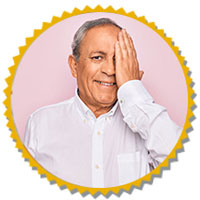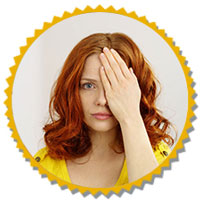Try These Three Fun Tests
to Find Your Visual Blind Spot
When we talk of “blind spots,” we always think of driving with an area of the road not visible through the rear-view or side-view mirrors. But there is another kind of blind spot that all humans have in each eye. These blind spots are natural, and we are not even aware of them because the brain fills in the gaps in our vision, based on whatever information it has about what our eyes are looking at.
The Simple Science Behind Blind Spots
If you’re interested in the science behind this phenomenon, it’s this:
Light enters the eye by passing through the pupil and hitting the retina at the back. The retina is encased in light-sensing proteins, which transmit what they sense to the optic nerve. The optic nerve, in turn, relays that message to the brain. The blind spots occur because the optic nerve ends in the field of the retina itself. Whatever shortfall there is about visual information, the brain fills in by looking at the surrounding picture, and as a result, we are never conscious of the existence of blind spots as we go about our day-to-day lives.
But they’re there alright, and you can test your own blind spot by looking at the images below:

Test #1: A + and a Circle
- Look at the image below with the plus sign and the circle.
- Look straight at the image, with your nose positioned somewhere between the plus and the circle.
- Close your left eye, and focus your eyes on the plus sign with your right eye. Do not look deliberately at the circle.
- Now move closer to the image, slowly. Don’t take your focus off the plus sign while you are doing this.
- At some point between 10”-14”, the circle will disappear from your peripheral vision. And the brain will read the surrounding white color to fill up the empty space.
- This exact spot is your blind spot.


Test #2: Now with Color
Now let’s try the same exercise with the new image below.
- Position your head to look straight at the image.
- Cover your left eye, and look at the plus in the middle of the green background with your right eye.
- Move closer to the screen as before. When you hit your blind spot, the circle will disappear, and the brain will fill the gap with the surrounding yellow color.


Test #3: A Color Changing Circle
The brain’s habit of using surrounding visual information to make up for a missing piece in the picture is even more apparent with this third image.
- Cover the left eye and look at the plus sign with your right eye.
- When you the hit the blind spot, the yellow circle will disappear, and the brain will fill the gap with another red circle – information it picked up by assessing all the red circles that make up the surrounding area.

Your vision may be more affected by blind spots than you realize! To learn more and discuss your options for vision correction, schedule a free consultation with the specialists at LASIK of Nevada today!
